Fall IDF 2005 - Day 1: Intel Introduces new Microprocessor Architecture
by Anand Lal Shimpi on August 23, 2005 12:08 PM EST- Posted in
- Trade Shows
Intel's New Micro-Architecture
Of course, the big story of the day is Intel's new focus for microprocessor architectures.
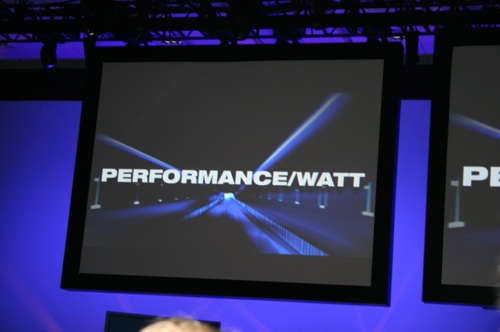
Intel's next microprocessor architecture will finally unify their desktop and mobile architectures, for a new focus on performance per watt as the driving force behind future CPU development.
Intel formally announced their first CPUs based on their next-generation microarchitecture: Woodcrest, Conroe and Merom. All of these CPUs will be built on a 65nm process and will be 64-bit enabled.
The new processors will be available in the 2H of 2006 and will significantly improve performance per watt over the current generation processors:
Woodcrest and Merom will both improve performance per watt by a factor of 3 over their predecessors.
Thanks to the death of NetBurst, Conroe will feature a 5x increase in performance per watt. Here's to the death of the power-hungry Intel processor.
Intel also set power consumption targets for the next-generation of systems based on these new 65nm processors:
On electrical cost savings alone, PC users will save $1 billion per year for every 100M computers.
The reduction in power will enable a new class of devices to be created at the 0.5W marker - the Handtop. The Handtop is basically a very small PC, that may end up being what everyone envisioned the Tablet PC as being.
Intel then went on to show off actual running silicon for all of their new CPUs, Conroe, Merom and Woodcrest.
Merom, a dual core mobile CPU, was running 64-bit Windows XP.
Intel had Conroe running a copy of Fedora Linux. Conroe is also a dual core product:
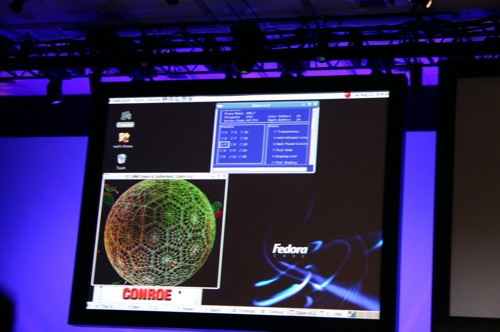
Intel's Woodcrest was running Windows Server 2003 in a DP configuration, with each processor featuring two cores:
We hope to have more information on Intel's new architecture as the week goes on, so stay tuned.


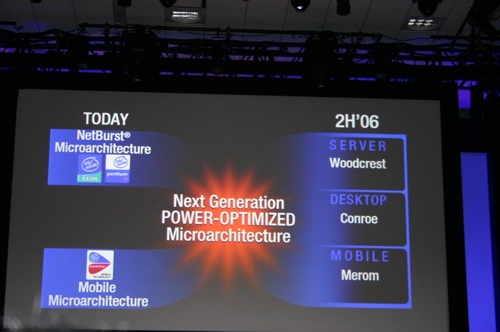
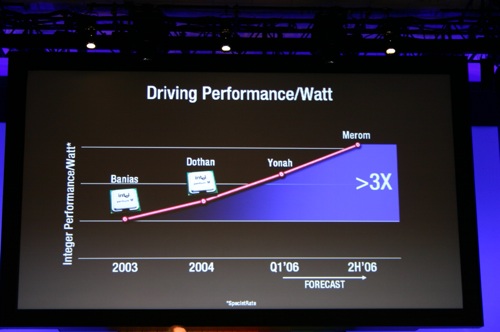
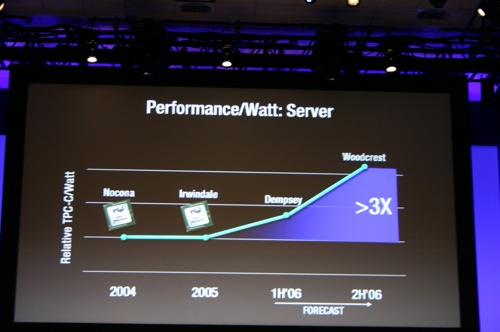


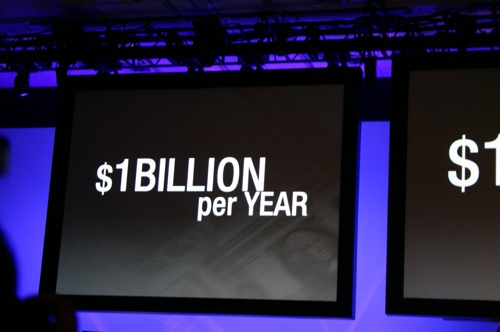
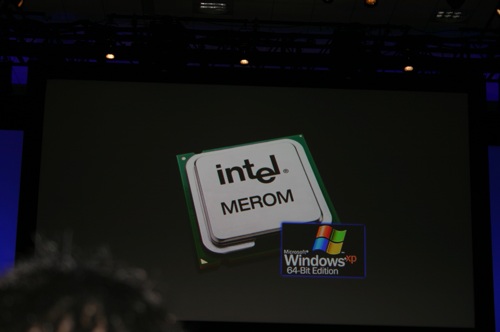
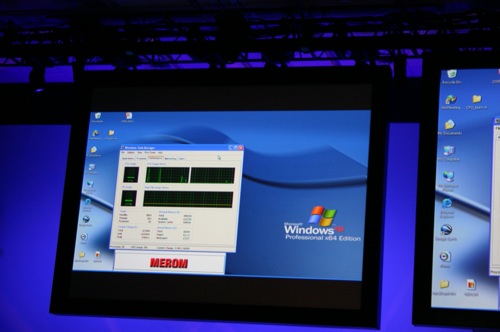
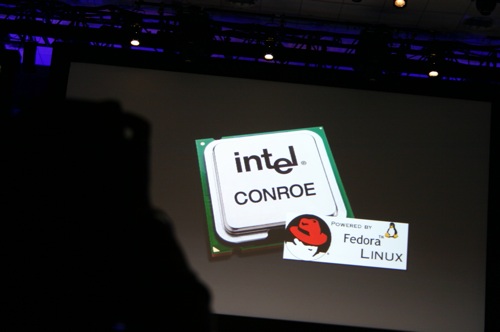










34 Comments
View All Comments
cHodAXUK - Tuesday, August 23, 2005 - link
Substitute 'new micro-architecture' with 're-jigged P3 core' and it would be much nearer to the truth.stateofbeasley - Tuesday, August 23, 2005 - link
Let me guess: you think K8 is a 're-jigged K7 core' too :roll;Anemone - Tuesday, August 23, 2005 - link
Ok the word is not to build 32 bit apps anymore. Who, aside from the stupid or desperate is going to buy Yonah when 4 months later you'd be able to get a 64 bit improved Merom? Can you just upgrade and drop a Merom into an appropriately prepared Yonah laptop? I doubt it, or they'd have been singing that song at the IDF.Yonah is just late. If it had been here Sep'ish and there was still 6-9mo till a 64bit version, it would have made some sense. If the Napa chipset had been built to accomodate both Yonah and an upgrade to Merom, it would have made sense.
Intel is either lying about the real schedules involved here, or they are desperately throwing out chip designs as fast as possible with little idea of planning.
Who knows..
stateofbeasley - Tuesday, August 23, 2005 - link
And most people are using (and will be using for a long time) 32-bit applications. Microsoft Office, IE, Outlook, FireFox, iTunes, etc. This is very basic stuff that simply doesn't benefit from 64-bit addressing. Windows XP x64 edition consequently offers no benefits to most users (Tomshardware just did a x64 edition test, their conclusion is that it is useless, PC World concluded the same).For the vast majority of consumers, Yonah will be just fine. Most people will never know the difference.
bob661 - Tuesday, August 23, 2005 - link
Office is going to 64 bit as well as those other apps you mentioned. This will happen sooner rather than later.Calin - Wednesday, August 24, 2005 - link
In a try by Microsoft to find reasons to force the upgrade of operating systems, taking another slide of the people's money.Too bad ( :) ) that they have big problems convincing people to upgrade from Office XP (or sometime Office 2000) to their latest greatest Office 2003.
Doormat - Tuesday, August 23, 2005 - link
Here's to hoping that these lower power chips will overclock better than the current P4 chips (at least without resorting to cascading phase change or liquid N2).Den - Tuesday, August 23, 2005 - link
If Conroe uses 65 watts and is about 5x as faster per watt than the current p4 3.8 which uses 135 watts (just over 2x 65) and if Conroe is dual core (another factor of two) then each core should be about 20% faster than a p4 3.8 GHZ to get up to a total of 5x better speed per watt. If this is really true, it is very exciting.Calin - Wednesday, August 24, 2005 - link
I lived under the impression that Northwood was more efficient per watt than Prescottmino - Wednesday, August 24, 2005 - link
It is.